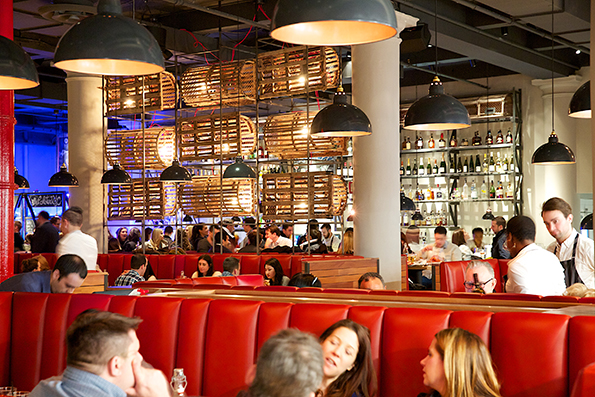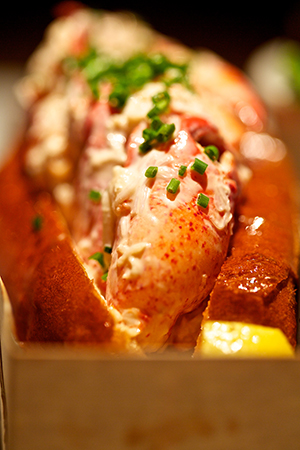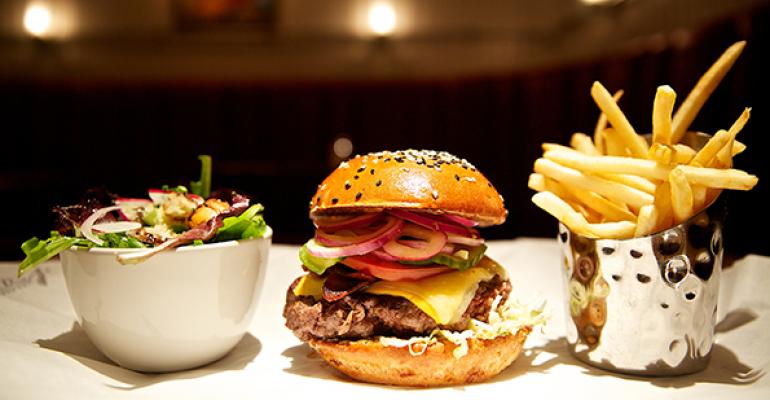Many restaurants that are performing well these days are those that don’t try to be everything to everyone, but instead stick to what they do best.
That’s the mission of Burger & Lobster, a 17-unit, upscale-casual chain based in London that doesn’t even have a menu. Customers have the choice of a hamburger, a 1.5-pound lobster or a lobster roll. Each item is served with a salad and fries, and everything is the same price — £20 in the United Kingdom ($27.40 — or $28.60 earlier this month), and $20 in the United States, where its first location, in New York City, opened in January 2015.
The chain is owned by four childhood friends who grew up in Moscow. Three of them are also involved in the British steakhouse chain Goodman. They later brought on former journalist Vladimir Borodin, once editor-in-chief of the major Russian daily Izvestia, who joined them in 2010 to restructure the company and now spearheads U.S. operations.
The group opened its first Burger & Lobster restaurant in 2011. The chain now has 14 company-owned locations: Ten in London, three in the United Kingdom — Manchester, Cardiff and Bath — and one in New York, as well as three franchises in Dubai, Kuwait and Stockholm.

“We believe in focusing on something rather than on doing a huge menu,” Borodin said. In fact, in proper Russian fashion, they wrote what they call a “monoproduct manifesto,” a page-long text about focusing on one product and doing it well. In fact, Burger & Lobster was originally envisioned as two separate restaurant concepts — one focusing on lobster, the other on burgers — that ended up merging.

“We believe when you focus on something, you can achieve the best quality ever,” Borodin said. “You can be very efficient in supply, storage, cooking, labor cost, etc. And what is the most important, your customer can be satisfied by the quality for the money.”
It’s not a unique idea. Chains such as Raising Cane’s succeed by keeping their menus simple — fried chicken tenders, fries and Texas toast in the case of Raising Cane’s. Even in the full-service world, Relais de Venise, an eight-unit chain based in Paris, which also has a location in new York, offers steak frites with a side salad at a fixed price. Customers only have the choice of steak temperature, wine and dessert.
But it was novel to the denizens of the London neighborhood of Mayfair, which is more familiar than most parts of town with Michelin-starred fine-dining restaurants. They didn’t know what to think of Borodin & Co.’s first restaurant when it opened in 2011.
“It was a super big surprise for them that one day there is Burger & Lobster,” Borodin said. “It didn’t make sense for them.”
But the strangeness of the place helped it take off, Borodin said.
“Because of all these questions it got really, really popular and full,” he said. “The press was very favorable and kind to us.”
Borodin added that making most of the decisions for his diners also seemed to appeal to his customers.
“You want to come to a restaurant to enjoy your company and spend a fun time. You don’t want to be stressed out. You don’t want to study the menus long enough to get bored. You don’t want to think about prices. Sometimes when you go to a restaurant with lobster on the menu, they say it is ‘market price,’ so actually you have no idea what would be the final price when you order it. So that’s additional stress,” he said.
Growing in the Big Apple
The New York location — the largest in the chain, with more than 300 seats — is doing well. It serves between 8,500 and 9,000 customers per week, at an average check of around $32, making for annual sales of more than $14 million. The restaurant has a full bar, including local craft beers, and a single $6 dessert of cheesecake mousse.
Borodin said lower prices on the menu in New York are managed by a shorter supply chain. The lobster for all of the restaurants comes from Nova Scotia, and the beef is from Nebraska — a blend of Hereford brisket, chuck and tri-tip blended by New York celebrity ground beef purveyor Pat LaFrieda.
It also helps that New Yorkers order more burgers than other customers. The sales mix in Manhattan is about 30 percent burgers, 30 percent lobster rolls and 40 percent lobster. About half of the London customers order whole lobsters. Bar sales account for around 30 percent of total checks at most locations.
The burger build is simple: The 10-ounce patty is cooked to the desired temperature and topped with a proprietary sauce, lettuce, tomato, American or Cheddar cheese, bacon, onions and pickles, which are made in house. A “California Burger,” served on lettuce instead of a bun, is also an option.
The owners manage lobster prices by buying them twice a year and storing them at locations in Halifax, Nova Scotia; Maine; and at a facility near London's Heathrow Airport.
The New York restaurant also has storage tanks in the basement for 4,000 lobsters — a week’s supply — with automatic control of temperature, oxygen and ammonia levels, and other factors all monitored remotely by the chain's Canadian biologist.
“So if something goes wrong it alerts them and our chefs are there,” Borodin said.
New York's second Burger & Lobster location is slated to open near Bryant Park early next year. After that, Borodin said he plans to open more locations in the city, as well as elsewhere in the U.S. He is also open to franchise requests, he said.
“Currently we are considering some offers in the country, but we are not in a rush,” he said. “We want to make sure that the guest has absolutely the same incredible experience, that the product is absolutely consistent and great in quality. So we are looking for quality restaurant professionals and partners.”
Contact Bret Thorn at [email protected]
Follow him on Twitter: @foodwriterdiary

